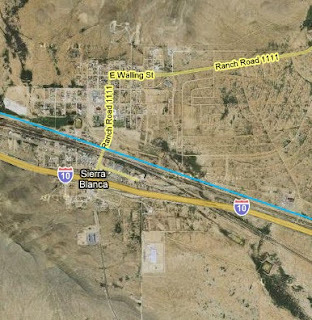 After leaving the irrigated valley of the Rio Grande and heading east (good direction!) on the Interstate 10, the route shows a few steep climbs, a lot of desert and very few settlements. It took, therefore, a bit of searching to unleash the geographical potential but in the spirit of 'geography is everywhere' , here's what I have found.....
After leaving the irrigated valley of the Rio Grande and heading east (good direction!) on the Interstate 10, the route shows a few steep climbs, a lot of desert and very few settlements. It took, therefore, a bit of searching to unleash the geographical potential but in the spirit of 'geography is everywhere' , here's what I have found..... 
From the air the terrain looks very unpromising yet it is not entirely barren and the vegetation cover, though sparse, is worth some discussion. This part of west Texas lies within (if only just) the eastern limits of the Chihuahuan desert. We mentioned the Chihuahuan desert a couple of days ago in this posting but apart from stating that it is a WWF recognised ecoregion, we did not give much consideration to the vegetation cover which is one the aspects which makes it unique.

This is typical Chihuahuan desert scenery - fewer cacti than the Sonoran and more drought resisting shrubs which include species such as creosote bush, mesquite, acacia and succulents like the agave and yucca(below) .
.
 .
.Mark's route yesterday took him through many miles of scenery like this with only a few small settlements as staging posts along the way. First was Sierra Blanca, a railroad junction where the Southern Pacific and Texas and Pacific lines meet .
.
 .
.In common with many of the small settlements in these parts, Ranch Road seems to be a common address and may be indicative of the main land use in the vicinity! Sierra Blanca has another claim to fame (or perhaps notoriety). You can read the full story here but basically, land just three miles from Sierra Blanca receives regular dumping of sewage sludge from New York, delivered weekly by train!
20 miles beyond Sierra Blanca is a tiny ranching community called Allamoore which has yet another curious, if not geographical, claim to fame having been named after the postmistress, a Mrs Alla Moore who ran a post office there at the end of the 19th century.  The fact that it also features in the list of Texan ghost towns is probably indicative of its fortunes in the intervening years. In happier times, there was some local employment in a nearby talc mine and rock crushing plant (the latter at appropriately named Crusher)
The fact that it also features in the list of Texan ghost towns is probably indicative of its fortunes in the intervening years. In happier times, there was some local employment in a nearby talc mine and rock crushing plant (the latter at appropriately named Crusher) .
.
 The fact that it also features in the list of Texan ghost towns is probably indicative of its fortunes in the intervening years. In happier times, there was some local employment in a nearby talc mine and rock crushing plant (the latter at appropriately named Crusher)
The fact that it also features in the list of Texan ghost towns is probably indicative of its fortunes in the intervening years. In happier times, there was some local employment in a nearby talc mine and rock crushing plant (the latter at appropriately named Crusher) .
.Another 10 miles east took Mark to Van Horn - decribed on the municipal website in the following terms "Van Horn, Texas, Crossroads of the Texas Mountain Trail, was part of the Old Spanish Trail through Texas. Van Horn ties South and West Texas together in history and geography. It rose out of the fundamental need for water in the Desert West. When the American highway system was built, the town became a welcome stop on Interstate 10 for travelers. Today, Van Horn is the seat of Culberson County government. "

This view of the main street in Van Horn gives a good indication of life in the town

 However, in the spirit of 'claims to fame' Van Horn turns out to be another place with a secret. In the near future it could become a centre for space tourism! On Friday, November 10, 2006, Jeff Bezos, founder and CEO of amazon.com , acquired 290,000 acres (1,200 km²) of land 40 km North of Van Horn to house his fledgling space tourism company, Blue Origin. The Wall Street Journal reported that Blue Origin may start operations as early as 2010, aiming for 52 launches per year from the Van Horn, Texas facility. Read all about it here.
However, in the spirit of 'claims to fame' Van Horn turns out to be another place with a secret. In the near future it could become a centre for space tourism! On Friday, November 10, 2006, Jeff Bezos, founder and CEO of amazon.com , acquired 290,000 acres (1,200 km²) of land 40 km North of Van Horn to house his fledgling space tourism company, Blue Origin. The Wall Street Journal reported that Blue Origin may start operations as early as 2010, aiming for 52 launches per year from the Van Horn, Texas facility. Read all about it here.The day's cycle ended for Mark between Van Horn and Kent with the anticipated meeting with BBC cameraman David Peate recounted on the Artemis web diary. Very close to where Mark camped last night I spotted this spillway for carrying surface run-off under the highway - a reminder that it may be desert but there are times of year when even deserts get rain and when they do, it can be heavy! 



No comments:
Post a Comment